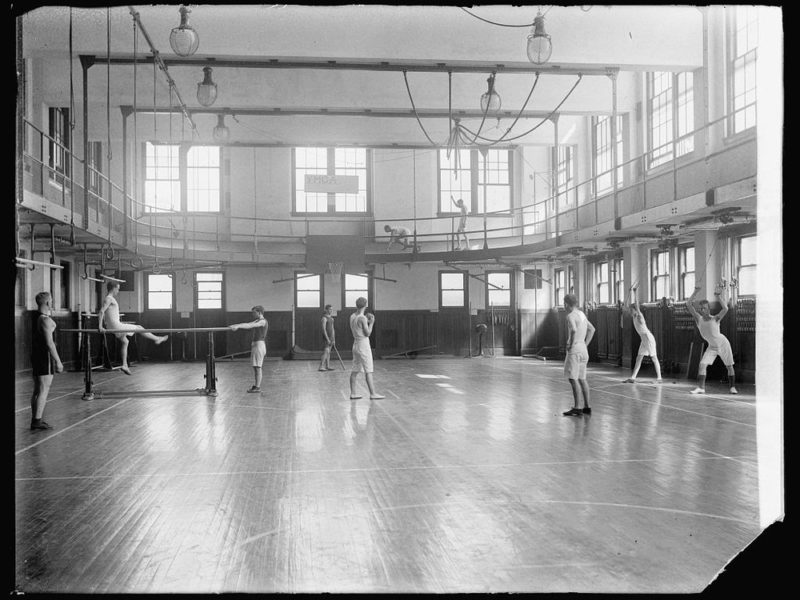The story of the gym told by the ancient Flock to the present day. Let’s discover together this incredible evolution.
Indice dei contenuti
Preface
The evolution of fitness comes from the human need to survive. Its evolution will then be closely linked to the evolution of our society and, consequently, to our way of life.
In this article we will talk about how the gym has gone from military training centers to places where modern man continually challenges his limits to forge the best version of himself.
Who invented the gym
The gymnasium was born in Greece and was the place where young people were educated in the arts of combat and philosophy. It consisted of a row of colonnades surrounding an open space where the strongest athletes trained to compete in the Olympics, held annually in honor of the idei. The word “gym” comes from the Latin palaestra, or fight, and refers to the open place we were talking about earlier.
The equipment we could find in a Greek gym was very rudimentary, as we preferred free body training, such as wrestling, and training endurance. It is precisely at this moment that the discipline of calisthenics is born, which in Greek means beautiful and strong. But there were also tools like javelin, discus and surprisingly something that we still use in our training – dumbbells, at that time called haltere.

*Training in a crater of ancient Gregia
Rebirth- 1800
With the disappearance of the Greek world, the world also forgets the values connected with it. So we shouldn’t be surprised by the secular absence of gyms as we know them, at least in Western culture. In the early 1800s there were the first experiments in Germany, but it was not the gyms that we meant.
The gym will have its renaissance only in the 19th century when colleges begin to build gymnasiums to support and enhance the performance of their young athletes, making the gym not only come back into vogue as a means to improve their level of health, but also for a desire to look more fit, accompanying training to more active diets and lifestyles. In this period we also begin to see a timid interest on the part of women who, upon entering college, decide to participate like their male colleagues in the new sports that are taking place in the university circle.
Hippolyte Triat and the first commercial gyms
Hippolyte Triat was a French gymnast and Strongman who is credited with opening the first commercial gymnasium. His club opened in Brussels in the 1940s. At the end of the century Eugene Sandow also created his first gym and in 1901 held the first fitness competition. He was the first to advertise a real lifestyle based on fitness, diet and machine use, opening a chain of gyms across England. To date, the award presented to Mr. Olympia bears the name of this pioneer of fitness.
Those who popularized fitness for the masses were the YMCA (Young Men’s Christian Association) which aimed at the growth of mind, body and spirit. It was in 1881 that in one of these gyms, in Boston, the term body building was coined that described a series of exercises, on which exercises practiced in all gyms in the world are still based.

*First YMCA gym
Jack Lalanne and the California Gold Gym
Jack Lalanne is a legend in the fitness world for having found great success in the creation of many machines, some still used today in gyms such as leg extensions and machines with pulley systems such as pulley cable. Although the doctors of the time advised against and considered dangerous the practices of lifting weights and rigorous workouts, Lalanne was able to contribute to the world of fitness with modern ideas, such as involving women in weight lifting, which unfortunately had little luck in the first period.
The Gold Gym was founded in California, in Venice Beach, in the late ’50s and is now a Mecca for all lovers of body building. Created by Joe Gold, will be responsible for the global popularization of the fitness phenomenon that will lead worldwide with the creation of the World Gym chain in 1977.
In the 80s began the wave of fitness mania, accomplices the first 24-hour fitness chains opened in America and Jane Fonda videos that will bring even the most obstinate housewives to approach the world of fitness.

*Arnold Schwarzenegger and the Gold Gym
History of the gym in the present
The big chains of gyms are still very popular but, as said at the beginning, with the evolution of our society also the way of conceiving fitness has changed. The cult of the image that is inculcated by social media leads us to demand from our body results that are constantly better and sometimes unreachable. How we pursue these goals is up to us and, thanks to the spread of gyms, we can choose the type of gym that best suits our needs.
The types of gym among which we can choose nowadays can be schematized into four categories:
-
- The gym with subscription: is the typical 24-hour gym that requires the payment of a monthly subscription, is the model that is closest to the “old” concept of gym, where those who train are generally left to themselves. This can be good for those who are already comfortable with tools and movements, but on the contrary it could leave newbies bewildered and at the mercy of machinery. These gyms also offer personal training, where training sessions are performed under the guidance of an expert. The price is certainly more substantial than the simple subscription, but the results are undeniable. The only trick is to choose the right trainer, as most of them are definitely not qualified to help new people at the gym and could end up doing more harm than good. Another option is group training led by an instructor who generally practice cardio exercises like Zumba or spinning, definitely not suitable for those who think of doing weightlifting.
- The gym h24: is a type of gym that is generally part of a chain, classes and machines that we can find inside change by the taste of the owner, as well as the quality and quantity of personal trainer. Generally the rate is calmierata, therefore the prices are contained. It is definitely an option for those who want to train without spending a fortune, having the opportunity to go there when it is most convenient.
- Cross Training: is a model that is based on the structure of classes, which can have high numbers of participants and follow a standardized training consisting of functional movements. Cross training certainly does not reflect everyone’s needs, but we believe that is for all. Thanks to the possibility of “climbing” the movements, the training is definitely adaptable to every fitness level. For the downsides it is obvious that at the level of schedules will not be compatible with everyone’s lifestyle, moreover the subscription is very expensive and the margin of choice of exercises is practically zero.
- The Bootcamp: easier than Cross Training because it includes quick free body exercises to learn. This is also played in large groups with a coach who follows everyone in a very minimal way. It is played outdoors and only in the colder months you find yourself in a gym. It is definitely a great way to burn calories easily without having to lock yourself in a gym.
</ol
The future of fitness
As we have seen in this article that talks about the history of the gym, fitness and gyms have come a long way since their dawn more than two thousand years ago, what remains to ask us is: in which direction is fitness going? With the advent of the pandemic from COVID-19 and lockdown we have seen an exponential growth of fitness programs online and via app. The trainers to make up for the social distance have organized outdoor classes and meetings via ZOOM to maintain contact with the public and it seems that this formula is liked by many, who prefer the comfort of their home to the environment, sometimes too competitive, of gyms.
But NOTHING will ever take away the taste of training in a real gym and this will remain in our opinion still a trend of exponential growth.
Conclusions
These new ways of training are multiplying, it’s true, but as anyone who has ever set foot in the gym can tell you: the experience and the sense of community that gives attending a gym is to practice spinning or follow a class of Cross Training will never go out of fashion.
As you know, at KingsBox we always like to innovate with new products and we invite you as always to visit our section dedicated to new and to innovations.






